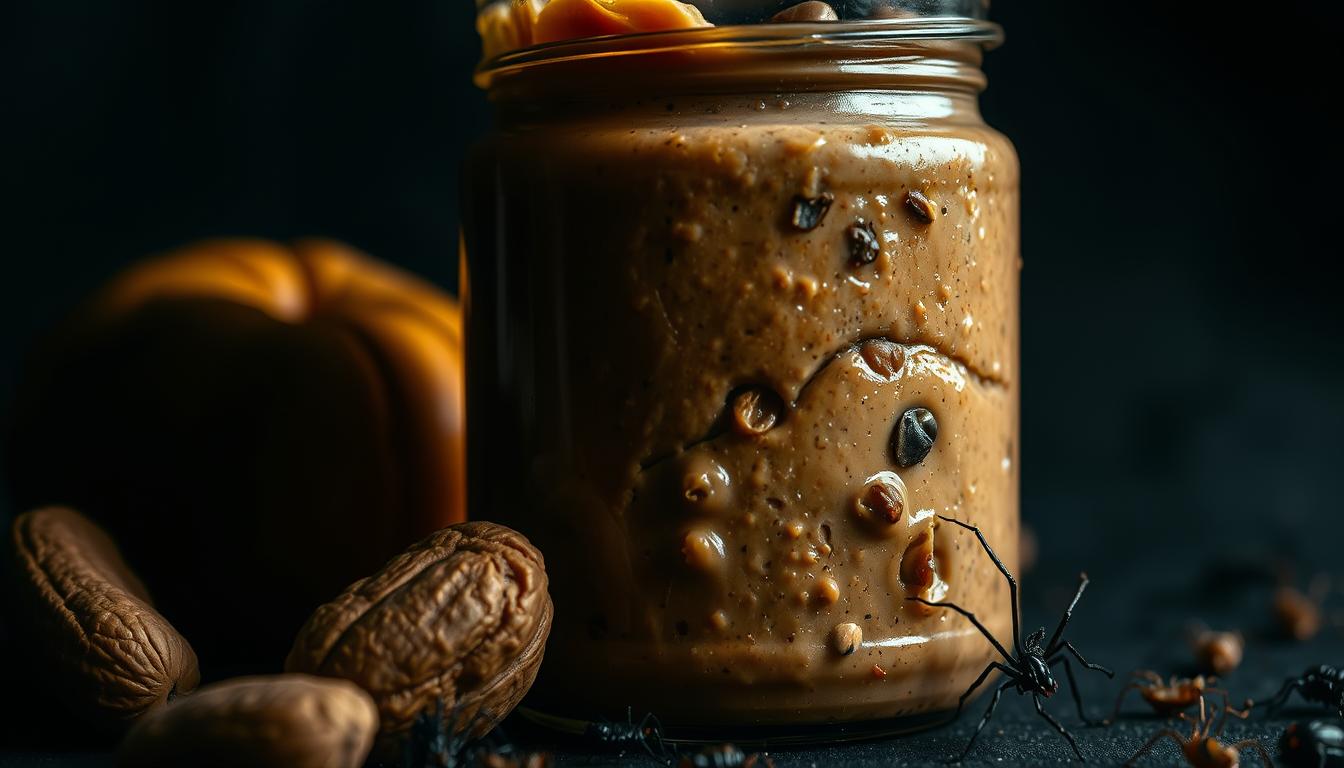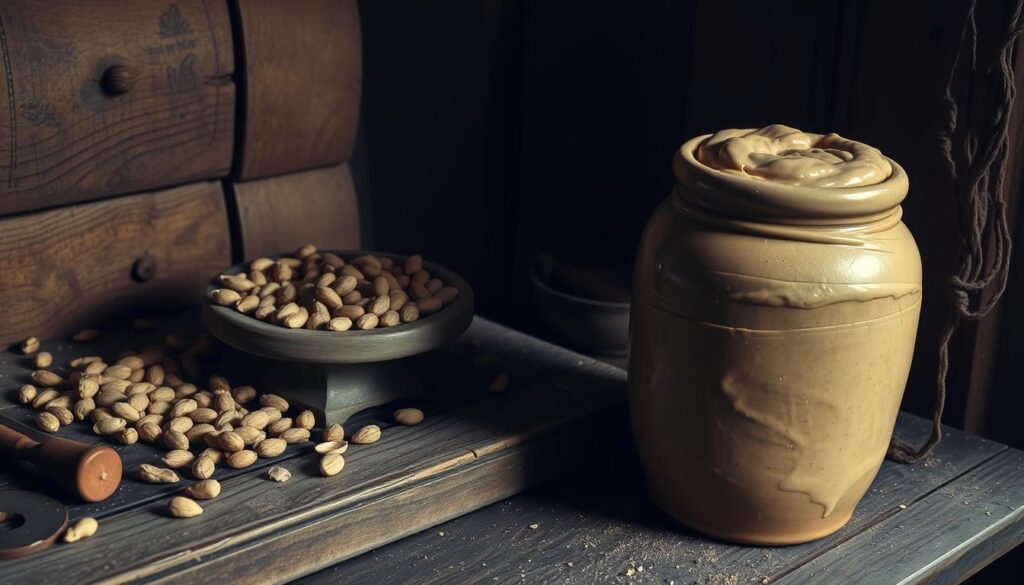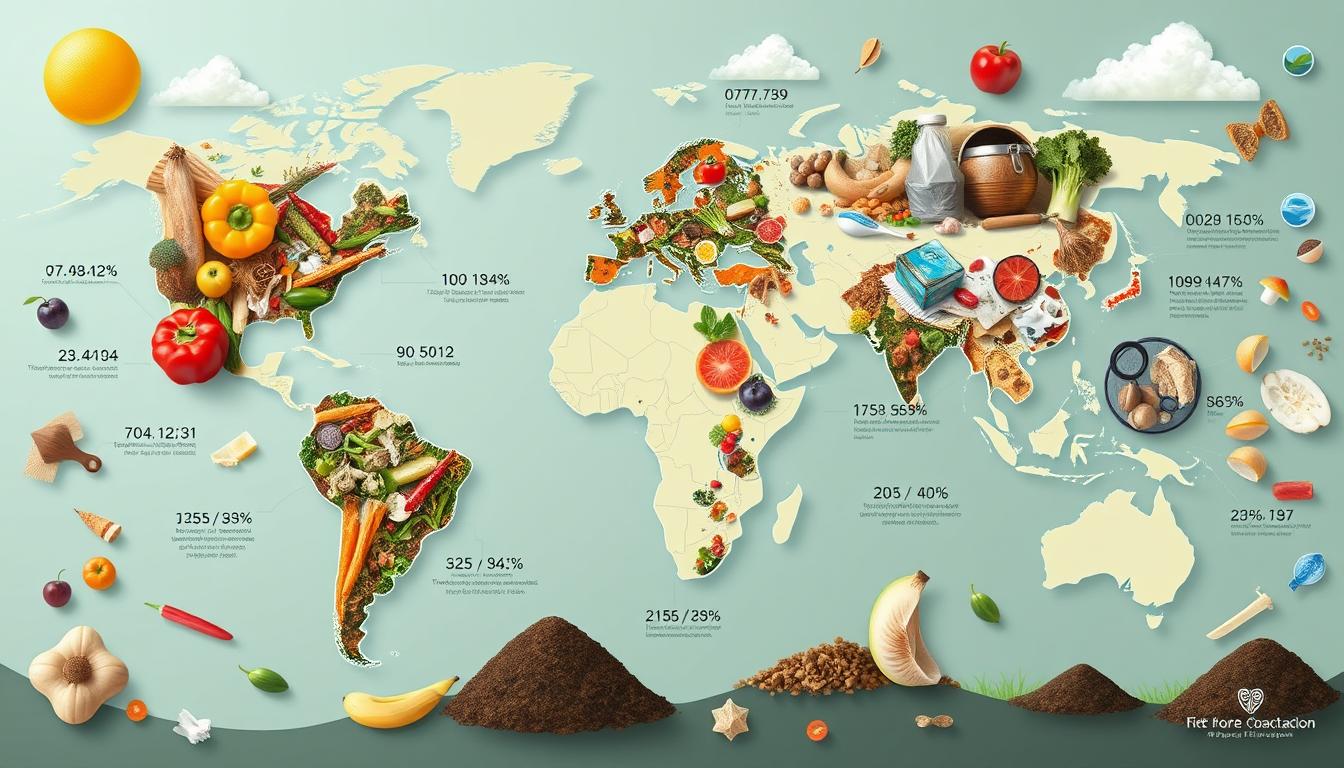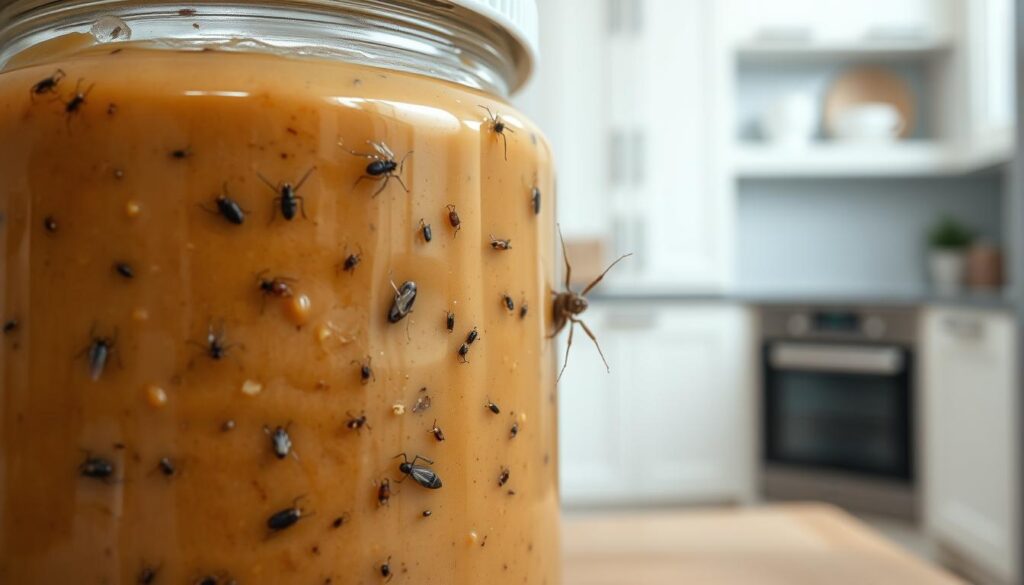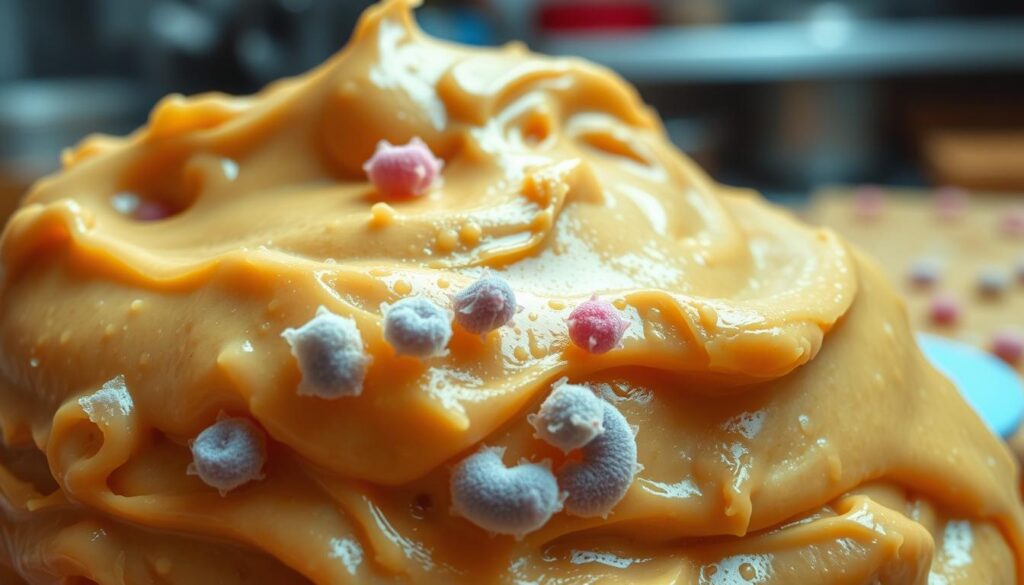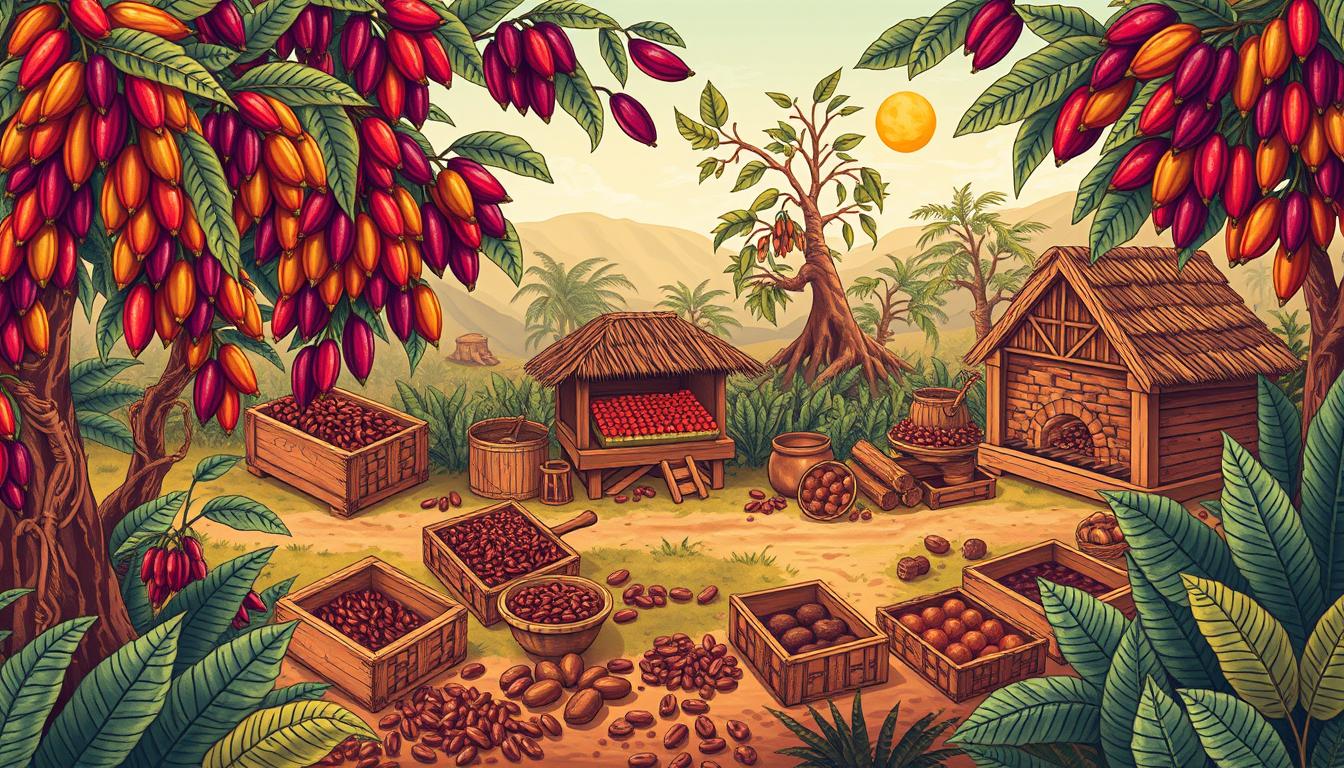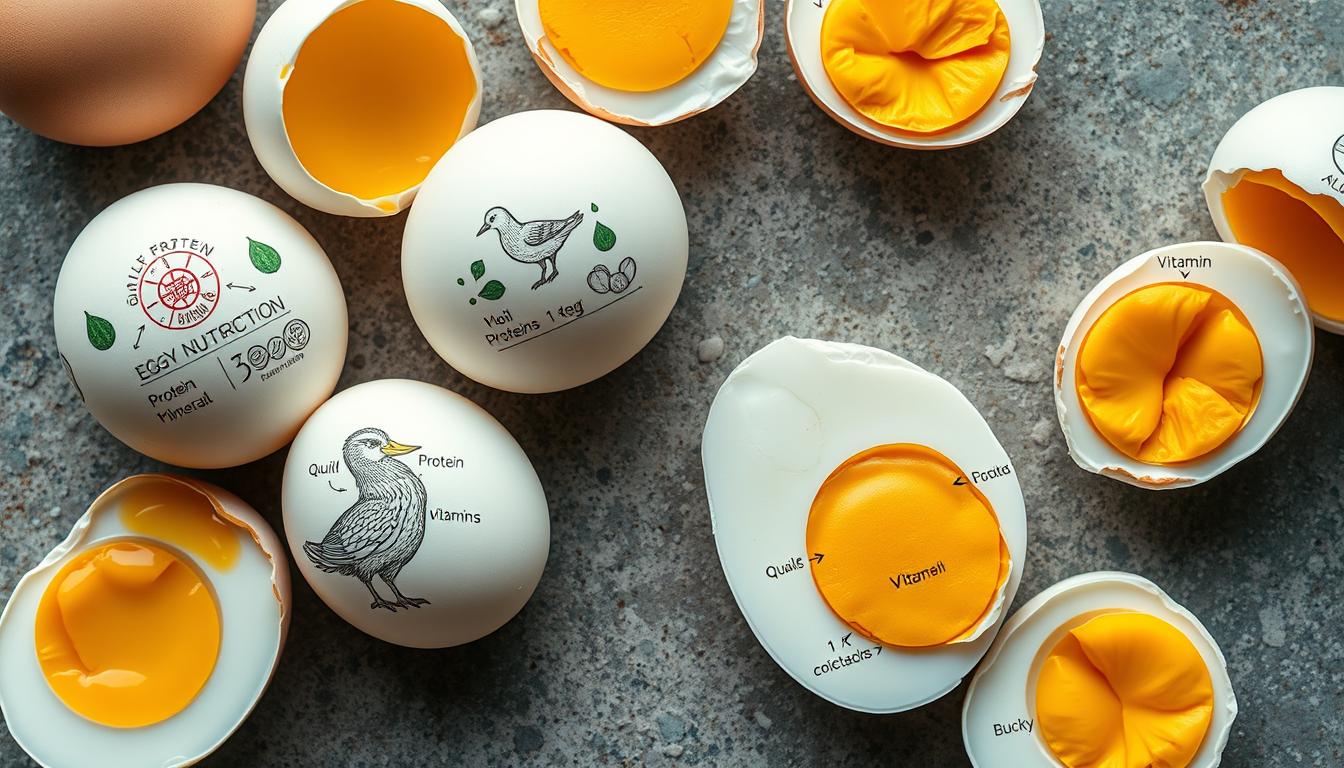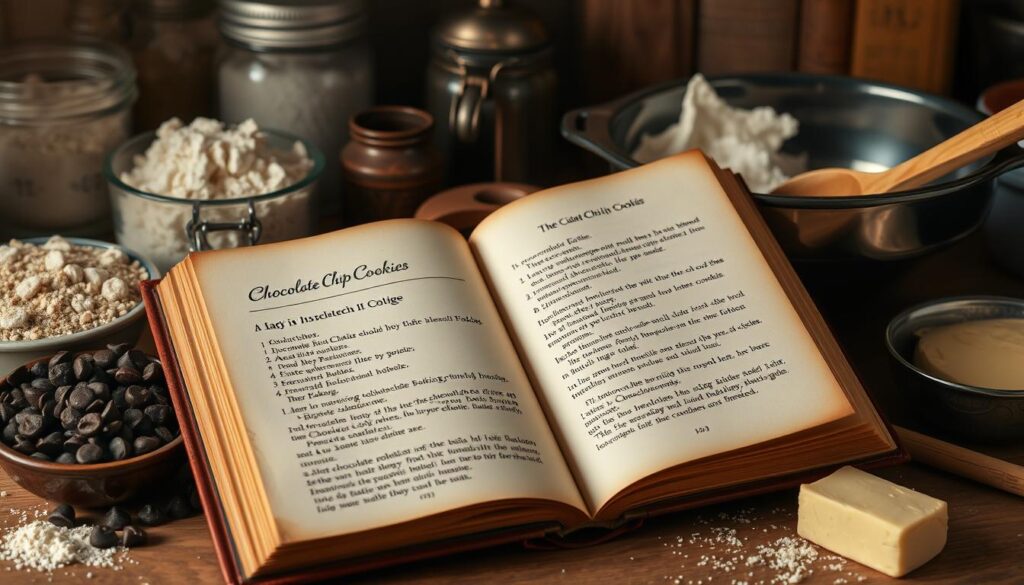Did you know it takes about 540 peanuts to make a single 12-ounce jar of peanut butter? This is just the start of the surprising facts about peanut butter. It’s a favorite in many American homes, with people eating almost 3,000 PB&Js in their lifetime. Yet, there are some unknown details about its making and ingredients that might shock you.
In the U.S., any product called “peanut butter” must be at least 90 percent peanuts. But what’s in the other 10 percent might surprise you. The FDA allows small amounts of insect fragments, rodent hairs, and even excreta in peanut butter. While these amounts are small and safe, it’s a thought that might make some peanut butter fans uneasy.
The history of peanut butter production has some unpleasant beginnings. Early methods were not well regulated, leading to possible bacterial growth and contamination. In 2015, the former CEO of the Peanut Corporation of America was sentenced to 28 years in prison. This was for shipping tainted peanut butter products, causing a Salmonella outbreak that killed nine people and made at least 714 others sick.
Despite these gross facts, peanut butter is very popular. Americans eat about 700 million pounds of peanut butter each year, enough to cover the floor of the Grand Canyon. There have even been world records set for eating peanut butter, like Patrick Bertoletti eating six peanut butter and jelly sandwiches in one minute in 2012, and Andre Ortolf consuming 378 grams of peanut butter in one minute in 2017.
Key Takeaways
- It takes about 540 peanuts to make a 12-ounce jar of peanut butter
- The FDA allows small amounts of insect fragments and rodent hairs in peanut butter
- Early peanut butter production methods led to possible bacterial growth and contamination
- Despite gross facts, peanut butter remains a popular food item with world records set for consumption
Table of Contents
- 1 The History of Peanut Butter: Not So Appetizing Origins
- 2 Gross Facts About Peanut Butter: FDA Allows Insect Fragments and Rodent Hairs
- 3 Bacterial growth during production
- 4 Peanut Butter Is a Nutrient-Dense Food, But Eat It in Moderation
- 5 High sodium content in some brands
- 6 Potential allergens and cross-contamination
- 7 Eating Peanut Butter Every Day Could Cause Health Problems
- 8 Yes, Peanut Butter Can Expire: Here’s How to Tell
- 9 The Peanut Butter Contamination Conundrum for Vegans
- 10 Peanut Butter by the Numbers: Shocking Statistics
- 11 The Science of Spread: How Peanut Butter is Made
- 12 The Environmental Impact: The Dark Side of Peanut Butter
- 13 Source Links
The History of Peanut Butter: Not So Appetizing Origins
Peanut butter has its roots in ancient Aztec and Incan societies. They ground roasted peanuts into a paste. Peanuts, like chickpeas or lentils, started in South America around 4,000 years ago. They became popular in the U.S. during the Civil War and after, as a snack.
Early peanut butter production methods
In 1884, Canadian inventor Marcellus Gilmore Edson patented peanut paste. The first peanut product patent was for “peanut candy” that year. The peanut butter we know today likely began in the late 19th century.
In 1895, Dr. John Harvey Kellogg patented a way to make raw peanuts into creamy spread. His recipe was different from today’s, as he boiled peanuts and didn’t add salt.
The first peanut butter-making machine patent was by Dr. Ambrose Straub in 1903. Early peanut butter faced issues with oil separation and quick spoilage.
The “Peanut Butter Case” and FDA regulations
The FDA has rules for making peanut butter. These rules allow some insect fragments and rodent filth. Here’s what the FDA says is okay in peanut butter:
| Defect | Allowable Level |
|---|---|
| Insect filth | 30 or more insect fragments per 100 grams |
| Rodent filth | 1 or more rodent hairs per 100 grams |
| Grit | 25 milligrams or more per 100 grams |
Despite these rules, peanut butter is very popular. The average American eats about 3 pounds of it each year. That adds up to almost 700 million pounds a year. For a healthier peanut butter option, try healthy chocolate peanut butter waffle cookies.
Gross Facts About Peanut Butter: FDA Allows Insect Fragments and Rodent Hairs
Get ready for some shocking facts about your favorite spread. The FDA says it’s okay for peanut butter to have insect fragments and rodent hairs. These might not be harmful, but they can make you think twice about using it.
Peanut Butter Can Legally Contain 30+ Insect Parts per 100 Grams
The FDA lets peanut butter have up to 30 insect fragments per 100 grams. These can get into your jar at any stage of making peanut butter. It’s not pleasant, but it’s a common issue in food production.
Rat Hairs and Excreta Are Also Permitted in Small Amounts
Peanut butter can also have one or more rodent hairs per 100 grams. The FDA has rules for these, but it’s unsettling to think about. Other foods like coffee beans and spices have similar rules.
These facts might be gross, but the FDA has them for safety reasons. It’s hard to remove all insects and rodents from food. If you’re really bothered, making your own peanut butter might be a better option.
Bacterial growth during production
Bacterial growth in peanut butter is a big worry for food safety. Making peanut butter involves steps where bacteria can get in, if safety rules aren’t followed. Even with added stabilizers like palm oil and sodium benzoate, keeping everything clean and checking quality is key.
Salmonella is a common bacteria found in peanut butter. It causes a lot of sickness worldwide, leading to thousands of deaths. In the U.S., there have been big outbreaks of Salmonella from peanut butter. For example, in 2007, 715 people got sick in 48 states. In 2009, 714 cases were reported in 46 states, with nine deaths.
To stop bacteria, peanut butter makers must follow strict safety rules. This includes:
- Choosing high-quality peanuts from trusted suppliers
- Keeping production areas clean and sanitized
- Using Hazard Analysis and Critical Control Points (HACCP) systems
- Testing for bacteria often
The peanut butter market has grown a lot, with a 6.1% growth rate from 2017 to 2021. As demand goes up, keeping food safe is more important than ever for manufacturers.
| Year | Salmonella Outbreak | Number of Cases | States Affected |
|---|---|---|---|
| 2007 | Salmonella Tennessee | 715 | 48 |
| 2009 | Salmonella Typhimurium | 714 | 46 |
| 2012 | Salmonella Brendeney | 42 | 20 |
| 2014 | Salmonella Braenderup | 6 | 5 |
Peanut butter with stabilizers can last longer without getting spoiled. It can stay good for 9–12 months unopened and 2–3 months after opening. Natural peanut butter, without stabilizers, lasts up to 12 months unopened and 3-4 months after opening, when kept in the fridge or pantry.
By knowing the risks and taking strong safety steps, makers can keep peanut butter safe for everyone to enjoy.
Peanut Butter Is a Nutrient-Dense Food, But Eat It in Moderation
Peanut butter is packed with protein, healthy fats, fiber, and essential nutrients. Two tablespoons have 8 grams of protein, meeting the daily needs for both men and women. It’s also higher in protein than most plant-based foods, with 22.5 grams per 100 grams.
Peanut butter is rich in healthy fats like oleic acid and linoleic acid, which fight inflammation. Two tablespoons of natural peanut butter also have about 3 grams of fiber, aiding digestion and preventing constipation. It’s a good source of phosphorous, niacin, zinc, magnesium, potassium, and vitamin E.
Two Tablespoons of Peanut Butter Contain 7-8 Grams of Protein
Two tablespoons of peanut butter have about 8 grams of protein. It’s a great protein source for athletes, providing energy during workouts. The protein in peanut butter helps with muscle growth and repair, making it popular among fitness lovers.
Peanut Butter Is High in Healthy Fats, Fiber, and Micronutrients
Peanut butter is not just high in protein but also in healthy fats and fiber. It has oleic acid and linoleic acid, which are good for the heart. It also has 3 grams of fiber in two tablespoons of natural peanut butter. Plus, it’s rich in vitamin E, niacin, vitamin B6, magnesium, copper, and manganese.
Eating Too Much Peanut Butter Can Lead to Weight Gain
While peanut butter is full of nutrients, it’s also high in calories, with two tablespoons having 190 calories. Eating too much can cause weight gain. But, a 2018 study found that eating nuts, including peanuts, might lower the risk of becoming overweight or obese. The key is to eat it in moderation and balance it with a healthy diet and exercise.
| Nutrient | Amount per 2 Tbsp Serving | % of Recommended Daily Intake |
|---|---|---|
| Protein | 7.02 g | – |
| Phosphorous | 107 mg | 15.3% |
| Niacin | 4.21 mg | – |
| Zinc | 0.85 mg | 7.7% (men), 10.6% (women) |
| Sodium | 152 mg | 10.1% |
| Saturated Fats | 3.05 g | 23.5% |
| Calories | 188 | – |
High sodium content in some brands
Choosing a healthy peanut butter means watching the sodium. Some brands have a lot of sodium, which is bad for those who don’t want too much salt. For example, JIF Reduced Fat Creamy Peanut Butter Spread has 190mg of sodium per 2 tablespoon serving. Skippy Reduced Fat Creamy Peanut Butter Spread has 170mg per 2 tablespoon serving.
The American Heart Association says we should not have more than 2,300mg of sodium a day. Ideally, it’s 1,500mg for most adults. Too much sodium can raise blood pressure, which is bad for the heart and brain.
But, there are low-sodium peanut butter options. These have less than 100mg of sodium per serving. They’re good for people with high blood pressure or those on a low-sodium diet.
When you buy peanut butter, check the nutrition labels. Look at the sodium content of different brands. Even natural peanut butter should be kept in the fridge to stay fresh. Choosing low-sodium peanut butter lets you enjoy it while keeping your diet healthy.
| Peanut Butter Brand | Serving Size | Sodium Content |
|---|---|---|
| Smucker’s Reduced Fat Peanut Butter | 2 Tbsp | 115mg |
| Peanut Butter & Co. White Chocolatey Wonderful | 2 Tbsp | 35mg |
| Peter Pan Creamy Original Peanut Butter | 2 Tbsp | 125mg |
| Reese’s Creamy Peanut Butter | 2 Tbsp | 140mg |
The table shows how different brands have different sodium levels. By picking a low-sodium option like Peanut Butter & Co. White Chocolatey Wonderful, you can enjoy peanut butter’s taste and nutritional benefits without too much sodium.
Potential allergens and cross-contamination
Peanut allergies are becoming more common, affecting about 1.6% of school-age kids. This number has gone up by 21% from 2010. People with peanut allergies need to be careful about what they eat, including peanut butter and other products with peanuts.
During peanut butter making, there’s a big risk of cross-contamination. Peanuts and tree nuts are often processed together. This can be dangerous for those with peanut allergies, as even a little bit can cause a reaction. Parents of kids with peanut allergies worry a lot about their kids getting accidentally exposed to peanuts.
To avoid cross-contamination, peanut butter makers must follow strict rules. They need to use separate lines for products with peanuts. It’s also important for people with allergies to wash their hands and clean surfaces before and after eating.
Peanuts are in many foods, like African, Asian, and Mexican dishes, ice cream, candy, and more. They can even be in non-food items like lotions, soaps, and lawn fertilizer. This makes it hard for people with allergies to stay safe.
Only about 20% of kids with peanut allergies grow out of it as adults. So, food makers and places need to focus on keeping people safe from allergies. Having a detailed allergy plan helps. It shows a place is serious about keeping people safe from peanuts.
Eating Peanut Butter Every Day Could Cause Health Problems
Peanut butter is a favorite in many homes, but eating it daily can cause health problems. One issue is peanut butter intolerance. This happens when your body reacts badly to peanut butter over time.
Symptoms of peanut butter intolerance include acne, fatigue, and skin rashes. These problems come from eating too much peanut butter. It has a lot of omega-6 fatty acids, which can cause inflammation and stress in the body. Just 2 tablespoons of peanut butter have 4,709 milligrams of omega-6 fatty acids and only 26.6 milligrams of omega-3 fatty acids.
Many peanut butter brands also have added sugars, salt, and hydrogenated oils. These can lead to high blood pressure and weight gain if eaten too much. Some brands have up to 3 grams of sugar per 2 tablespoons, adding a lot of sugar to your diet. Peanut butter is also very calorie-dense, with 190 calories in a standard serving size.
Other peanut butter side effects include:
- Acid reflux and damage to the esophagus lining, which is a problem for those with GERD
- High cholesterol, diabetes, and heart disease from saturated fats in some brands
- Neurological issues from aflatoxin, a mycotoxin in some peanuts, leading to chronic fatigue, ADHD, depression, liver disease, and cancer
- Indigestion, constipation, and stomach aches from the high fat content
To avoid peanut butter intolerance and other health issues, eat peanut butter in moderation. Choose natural, unsweetened brands to reduce harmful additives.
| Peanut Butter Intolerance Symptoms | Potential Causes |
|---|---|
| Acne | Inflammation and oxidative stress from excessive omega-6 fatty acids |
| Fatigue | Mycotoxin aflatoxin in some peanuts |
| Skin rashes | Inflammatory immune reactions to peanuts |
Your Body Can Build Up an Intolerance to Peanut Butter
While not as severe as a peanut allergy, peanut butter intolerance can cause discomfort. It develops over time due to the body’s struggle to process omega-6 fatty acids and other harmful components in peanut butter.
Symptoms of Peanut Butter Intolerance Include Acne, Fatigue, and Skin Rashes
If you get acne, fatigue, skin rashes, or unexplained weight gain after eating peanut butter, you might have intolerance. These symptoms are due to inflammation, oxidative stress, and the body’s inability to process peanut butter’s components.
Yes, Peanut Butter Can Expire: Here’s How to Tell
Peanut butter is a favorite in many homes. But, like all foods, it has a shelf life. Knowing when peanut butter expires and how to spot spoiled peanut butter is key to avoiding bad food.
Unopened Peanut Butter Lasts 6-9 Months in the Pantry
Unopened peanut butter can stay good for 6-12 months at room temperature, and opened peanut butter lasts 2-3 months in the pantry or 6-8 months in the fridge. Smooth and crunchy types last a year in the pantry when sealed. But, natural peanut butter without additives lasts only 2-3 months.
Opened Peanut Butter Is Good for 2-3 Months at Room Temperature
After opening, peanut butter lasts 2-3 months in the pantry. Smooth and crunchy types last 6-8 months in the fridge when opened. Natural peanut butter spoils faster without additives. It usually goes bad in a month or two in the fridge.
Storing peanut butter in the fridge extends its life more than in the pantry. Unopened natural peanut butter can last 6 months or more in the fridge. Opened natural peanut butter may last 3-4 months in the fridge.
Signs of Spoiled Peanut Butter Include Dark Color, Dry Texture, and Sour Taste
To check if peanut butter has spoiled, look for dark color, dry texture, and sour taste. Natural peanut butter might separate oil, which is normal. But, too much oil on top could mean it’s gone bad.
It’s important to throw away expired peanut butter for the best taste and texture. While most peanut butters have best-by dates, these are not safety indicators. They show when the product is at its freshest.
| Type of Peanut Butter | Unopened Pantry | Unopened Refrigerator | Opened Refrigerator |
|---|---|---|---|
| Smooth Peanut Butter | 1 year | 1 year | 6-8 months |
| Crunchy Peanut Butter | 1 year | 1 year | 6-8 months |
| Natural Peanut Butter | 2-3 months | 3-6 months | 5-6 months |
| Homemade Peanut Butter | – | – | 3-6 months |
Understanding peanut butter’s expiration and how to store it right keeps your favorite spread safe and tasty. Always trust your senses and toss any peanut butter that looks, smells, or tastes off.
The Peanut Butter Contamination Conundrum for Vegans
Vegans face a big problem with peanut butter. It can have insect parts and rodent filth. The FDA says it’s okay in small amounts, but it’s a big issue for vegans. This has led to talks in Congress, with people from Michigan, California, and Texas talking about food safety.
Many vegans think it’s okay to eat a little bit of insect parts in peanut butter. They say it’s not against vegan rules. But, some vegans want stricter rules to make peanut butter safer.
This problem isn’t just for vegans. In 2002, a meat plant had to recall 270 pounds of E.coli O157:H7 contaminated ground beef. This shows we need better food safety everywhere. The USDA’s Food Safety Inspection Service (FSIS) has been checking meat for years, but we need to keep watching.
There was also a big problem with lentil sausage crumbles. It made 386 people sick, with 130 needing to go to the hospital and 20 needing their gallbladders removed. The company, Daily Harvest, was popular for its healthy and easy-to-make frozen foods. This shows even healthy foods can be risky if they’re not made safely.
| Contaminant | Allowed Amount per 100g |
|---|---|
| Insect Fragments | 30 or more |
| Rodent Hairs | 1 or more |
| Rodent Excreta | Not specified |
We need to know about the risks in our food. We should support companies that make safe food. By pushing for better rules, we can make food safer for everyone. When making gluten-free waffle cones or other treats, use safe ingredients for the best taste.
Peanut Butter by the Numbers: Shocking Statistics
Peanut butter is a favorite in many American homes. But the facts about it might surprise you. The global peanut butter market is set to hit $8.6 billion by 2032. Regular peanut butter makes up 38% of this market. The US leads in both production and consumption of peanut butter.
In the US, people eat about 3 pounds of peanut butter each year. This adds up to nearly 700 million pounds for the whole country. Kids here will eat over 1,500 peanut butter sandwiches before they graduate. Australia also loves peanut butter, just like the US.
Global Peanut Butter Production and Consumption
India is the top exporter of peanut butter, sending out 31,328 units. But China eats the most peanut butter, consuming 4,210 TMT in 2023. India is the second-largest consumer at 1,494 TMT. Countries like France, the US, Japan, Germany, Canada, and the UK also import a lot of peanut butter.
The peanut butter market grew from $5.1 billion in 2022 to $5.6 billion in 2024. It’s expected to reach $8.6 billion by 2032. This growth is partly due to the rise in demand for healthier syrup options for waffles.
Average American Peanut Butter Consumption
Peanut butter is not popular in many countries, like the UK and China. But in the US, it’s a favorite. About 60% of people prefer smooth peanut butter, with men often choosing crunchy.
The price of peanut butter has gone up by nearly 94% from 1997 to 2024. Yet, Americans keep buying and eating it. This makes peanut butter a beloved item in many homes.
The Science of Spread: How Peanut Butter is Made
The journey from peanuts to peanut butter is fascinating. It turns simple peanuts into a creamy spread we all love. Let’s explore how peanut butter is made and its ingredients.
The Peanut Butter Manufacturing Process
The first step is roasting peanuts to boost their flavor and smell. Then, the peanuts are blanched to remove their skins. After that, they’re ground into a smooth paste.
This paste is mixed with sugar, salt, and stabilizers. This creates the perfect taste and texture.
Back in the early 1900s, inventors like Dr. John Harvey Kellogg and Ambrose Straub created machines for making peanut butter. Today, thanks to modern tech, making high-quality peanut butter is easier than ever.
You can also make peanut butter at home. Just roast peanuts, then grind them with sugar, salt, and oil until smooth. Whether made in a factory or at home, the process is the same.
Ingredients in Commercial Peanut Butter
Commercial peanut butter often has extra ingredients. These add texture, flavor, and help it last longer. Some common ones are:
- Sugar
- Salt
- Hydrogenated vegetable oils (stabilizers)
- Emulsifiers like mono and diglycerides
In the U.S., “peanut butter” must be at least 90% peanuts. Peanuts have a lot of oil, so stabilizers are added to keep it smooth.
| Ingredient | Purpose |
|---|---|
| Peanuts | Main ingredient, provides flavor and texture |
| Sugar | Sweetens and enhances flavor |
| Salt | Enhances flavor and acts as a preservative |
| Hydrogenated vegetable oils | Stabilizers that prevent oil separation |
Peanut butter tastes great and is versatile. But, it’s high in fat and calories. It’s good for healthy fats, protein, and fiber, but eat it in moderation.
By 2020, almost 90% of American homes had peanut butter. Peanut butter’s popularity keeps growing. Its place in our hearts and kitchens is secure.
The Environmental Impact: The Dark Side of Peanut Butter
Peanut butter production has a big environmental impact. The carbon footprint and water usage in peanut farming are major concerns. The production process, including transportation and processing, adds to the carbon footprint.
Peanut farming uses a lot of water. It takes 3.2 gallons of water to produce just 1 ounce of peanuts. This is less than what almonds need, but it’s a strain on water resources in farming areas.
Carbon Footprint of Peanut Butter Production
The carbon footprint of peanut butter production is complex. It involves farming practices, transportation, and processing. A 100-gram serving of peanut butter has 22 grams of carbs, 22.5 grams of protein, and 51 grams of fat. These contribute to its environmental impact.
To reduce the carbon footprint, peanuts should come from local farmers. Using energy-efficient processing and optimizing transportation routes also helps.
Water Usage in Peanut Farming
Water usage in peanut farming is a big concern, mainly in areas with drought or water scarcity. Peanuts need less water than some crops, like almonds. But, the growing demand for peanut butter strains water resources.
Using water-efficient irrigation systems and sustainable farming methods can lower the water footprint of peanut production.
Source Links
- 25 Fun Facts about Peanuts & Peanut Butter – https://nationalpeanutboard.org/news/fun-facts/
- 10 Surprising Peanut Butter Facts – Listverse – https://listverse.com/2019/03/05/10-surprising-peanut-butter-facts/
- Crunchy or Wrong [Peanut Butter] – https://order-of-the-jackalope.com/crunchy-or-wrong/
- 15 Facts About Peanut Butter You Should Know – Tasting Table – https://www.tastingtable.com/1246772/peanut-butter-facts/
- Bugs, rodent hair and poop: How much is legally allowed in the food you eat every day? | CNN – https://www.cnn.com/2019/10/04/health/insect-rodent-filth-in-food-wellness/index.html
- 9 Disgusting Things That the FDA Allows in Your Food – https://www.livescience.com/55459-fda-acceptable-food-defects.html
- Peanut Butter Food Safety Concerns—Prevalence, Mitigation and Control of Salmonella spp., and Aflatoxins in Peanut Butter – https://pmc.ncbi.nlm.nih.gov/articles/PMC9265579/
- Does Peanut Butter Go Bad? How to Spot a Spoiled Jar – https://greatist.com/eat/does-peanut-butter-go-bad
- Is peanut butter good for you? Health benefits and nutrition – https://www.medicalnewstoday.com/articles/323781
- Is Peanut Butter Healthy? The Good and the Bad of Peanut Butter – https://cleancookingcaitlin.com/is-peanut-butter-healthy-the-good-and-the-bad-of-peanut-butter/
- 45 Peanut Butter Nutrition Facts – https://ohmyfacts.com/food-beverage/45-peanut-butter-nutrition-facts/
- 8 Unhealthiest Peanut Butters, According to Dietitians – https://www.eatthis.com/unhealthiest-peanut-butters/
- 31 Piquant Peanut Butter Nutrition Facts | FactRetriever.com – https://www.factretriever.com/peanut-butter-nutrition-facts
- Persistence of peanut allergen on a table surface – https://pmc.ncbi.nlm.nih.gov/articles/PMC3599460/
- Peanut Pandemonium: How to Handle Peanut Allergies in the Food Industry – https://trust20.co/blog/peanut-allergies
- Ugly Side Effects of Eating Too Much Peanut Butter, According to Science – https://www.eatthis.com/ugly-side-effects-eating-too-much-peanut-butter/
- Warning Signs You’re Eating Too Much Peanut Butter – https://www.eatthis.com/news-dangerous-side-effects-too-much-peanut-butter/
- Does Peanut Butter Go Bad, and Does It Need to Be Refrigerated? – https://www.healthline.com/nutrition/does-peanut-butter-go-bad
- How Long Does Peanut Butter Last? Shelf Life, Storage, Expiration Date – https://eatbydate.com/proteins/nuts/how-long-does-peanut-butter-last-shelf-life-expiration-date-food-storage/
- Does Peanut Butter Expire? – https://www.cozymeal.com/magazine/does-peanut-butter-expire
- CAN THE FDA ASSURE THE SAFETY AND SECURITY OF THE NATION’S FOOD SUPPLY? – https://www.govinfo.gov/content/pkg/CHRG-110hhrg45731/html/CHRG-110hhrg45731.htm
- PDF – https://www.r-calfusa.com/wp-content/uploads/haccp/111017_confessions_munsell.pdf
- The Daily Harvest Food Poisoning Scandal – Maintenance Phase – https://maintenancephase.buzzsprout.com/1411126/episodes/11604492-the-daily-harvest-food-poisoning-scandal
- Peanut Butter Statistics 2024 By Values, Nutrition, Source – https://media.market.us/peanut-butter-statistics/
- How Peanut Butter Works – Stuff You Should Know | iHeart – https://www.iheart.com/podcast/1119-stuff-you-should-know-26940277/episode/how-peanut-butter-works-62553749/
- Peanut Butter: 15 Facts You Should Know About The Sandwich Staple – Mashed – https://www.mashed.com/229504/the-untold-truth-of-peanut-butter/
- The Spread of Peanut Butter – Savor | iHeart – https://www.iheart.com/podcast/105-savor-28019899/episode/the-spread-of-peanut-butter-29453469/
- The Truly Bizarre Origins Of Peanut Butter – The Daily Meal – https://www.thedailymeal.com/1279925/bizarre-origins-peanut-butter/
- A Brief History of Peanut Butter – https://www.smithsonianmag.com/innovation/brief-history-peanut-butter-180976525/
- Role of Aflatoxin in Peanut Butter: Health Risks & Safety – https://pronut.in/role-of-aflatoxin-in-peanut-butter/?srsltid=AfmBOop1Fvov8RjMl9bmbQE8bQFt4yaJgUa9o9g0LijFZoTWaLZh98Fn
